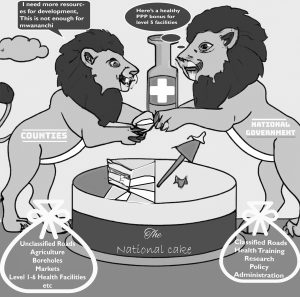[gravityform id=”1″ title=”false” description=”false” ajax=”true”]
Mashariki Television Networks Limited Email: info@themasharikinewspaper.com
Email Us
Our address
Mashariki Communications Centre
Meru-Maua Road
Main Telephone: +254 797 372 837
Postal Address: P. O. Box 747-60200, Meru, KenyaWe are social

The recent announcement by President William Ruto that his administration is committed to handing over the remaining functions to the county government is the best news for Kenya at a time like now when residents of various parts of rural Kenya are aspiring for more development projects and programs that are aimed at uplifting their lives.
Since devolution kicked off more than a decade ago, the impact of county government has been witnessed and felt in both rural and urban areas. There is improvement in infrastructure; provision of water services, improved and better-coordinated healthcare as well as visible social services that have made the people grow an element of ownership to the governors and the entire county governments.
Gone are the days when the majority of members of the public queued and demonstrated in the provincial administration offices seeking services and other governance issues.
Looking keenly at a department of health, one will realize most health provision services are done at health facilities from level 1 to level 5 hospitals that are under county government, while the national government is left to manage level 6 hospitals, manage research, and train health workers.
Most of the Ministry of Agriculture services are managed by the county government and the Kilimo House team is left to work on policy and manage research.
In the education sector, the county government manages ECDE and vocational training centers previously known as village polytechnics while the national government manages primary, secondary, technical, and vocational colleges and universities.
The Department of Water seems to be sharing equally between the two levels but the impactful services like community water projects and boreholes are done by the county government. In contrast, the national government concentrates on flagship projects like dams.
On the other hand, the roads and infrastructure department is managed by both the county and national government where parastatals like KENHA, KURA, and KERRA manage all the classified roads in the country, the county government is left to maintain and manage feeder roads that are mainly unclassified.
In most cases, the county governments are seen to intervene when the national government fails to work on roads allocated to them.
Cooperatives, Trade, Sports, and other social services-related duties are also shared by the two levels of government a situation that has sometimes created confusion.
Sometimes one can come across scenarios where the national government constructs a sports stadium and later hands it over to the relevant county government, leaving the question, why did the national government not allocate the money to the county government to construct the project? In some cases, such projects are funded by the two governments.
With only 15% of the equitable share going to the counties, one wonders what the national government is left to do with the 85% that remains there.
It is time for the national government to release the remaining functions to the county governments together with money and other resources that come with them. That way the impact of devolution will be felt more in the country.

Comments (0)